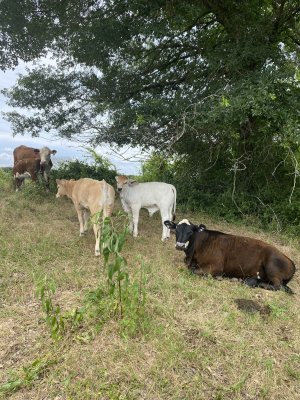Lucky_P
Well-known member
Calf survivability in adverse conditions.... look at dam's level of nutrition, particularly in the last trimester. Inadequate dietary protein intake will result in calves that have difficulty generating body heat, getting on their feet, and nursing. Add to that, colostrum quality may be adversely impacted.
That said, Sire may have some effect...
@KyHills - I hear you on those PrimeTime calves - we used him heavy for a couple of years when we were on the 'need to make 'em smaller' kick (he was a 4.0 frame bull). Those little suckers would jump up and run a mile away if you spooked 'em. I had one that ran through 4 fences, 3 adjacent properties, crossed a paved road; another ran the length of the farm and bailed into a flood-swollen creek - and when my wife got him out and we released him to his dam, he ran the length of the farm, a mile in the other direction and bedded down right at the top of the creekbank - we just left him alone then..
We decided that unless they were still wet and had not gotten to their feet, we would go out of our way to avoid any excitement, and just tag them after they'd had 48 hrs or so to 'bond with mama'.
@GoWyo - I loved my Gardens Wave daughters. Mine were not as ugly as the N Bar Prime Times - those were so ugly that you couldn't hardly stand to look at them until they got to be about 5-6 yrs old... But the Waves were nice little cows with good dispositions (I was worried when his initial DOC score came out at -23!, after I'd already used a cane of semen) Never saw carcass data on any of their calves, but with his combination of high marbling, high ribeye and high positive $EN... I felt like they were probably capable of producing some of the best steers in the herd... but they mostly dropped heifers (sired by either Shorthorn or Braunvieh bulls), all of which stayed in the herd.
That said, Sire may have some effect...
@KyHills - I hear you on those PrimeTime calves - we used him heavy for a couple of years when we were on the 'need to make 'em smaller' kick (he was a 4.0 frame bull). Those little suckers would jump up and run a mile away if you spooked 'em. I had one that ran through 4 fences, 3 adjacent properties, crossed a paved road; another ran the length of the farm and bailed into a flood-swollen creek - and when my wife got him out and we released him to his dam, he ran the length of the farm, a mile in the other direction and bedded down right at the top of the creekbank - we just left him alone then..
We decided that unless they were still wet and had not gotten to their feet, we would go out of our way to avoid any excitement, and just tag them after they'd had 48 hrs or so to 'bond with mama'.
@GoWyo - I loved my Gardens Wave daughters. Mine were not as ugly as the N Bar Prime Times - those were so ugly that you couldn't hardly stand to look at them until they got to be about 5-6 yrs old... But the Waves were nice little cows with good dispositions (I was worried when his initial DOC score came out at -23!, after I'd already used a cane of semen) Never saw carcass data on any of their calves, but with his combination of high marbling, high ribeye and high positive $EN... I felt like they were probably capable of producing some of the best steers in the herd... but they mostly dropped heifers (sired by either Shorthorn or Braunvieh bulls), all of which stayed in the herd.


